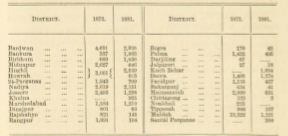Baiti
This article is an extract from
THE TRIBES and CASTES of BENGAL. Ethnographic Glossary. Printed at the Bengal Secretariat Press. 1891. . |
NOTE 1: Indpaedia neither agrees nor disagrees with the contents of this article. Readers who wish to add fresh information can create a Part II of this article. The general rule is that if we have nothing nice to say about communities other than our own it is best to say nothing at all.
NOTE 2: While reading please keep in mind that all articles in this series have been scanned from a very old book. Therefore, footnotes have got inserted into the main text of the article, interrupting the flow. Readers who spot scanning errors are requested to report the correct spelling to the Facebook page, Indpaedia.com. All information used will be duly acknowledged.
Contents |
Baiti
Brioti, a small caste of Central and Eastern Beno-al, usually called Chunari or Chuniya, from being engaged in the ~anufacture of lime from shells. They are also mat-makers, weavers, dancers, and beggars.
Internal structure
Regarding the internal structure of the caste very little is known. The Baitis of Dacca all belong to one section, AI iman, and thus, like several other castes of Eastern Bengal, habitually transgress the rule of exogamy implied in the recognition of a section-name. A degraded sub-caste is found in Faridpur, under the name of Magi, the members of which do not intermarry with the Baitis of Dacca. In the 24-Parganas Musalman Baitis are found. These, of course, do not intermarr~ with Hindu Baitis, nor do they follow the characteristio occupation of making lime.
The Purohit of the Baiti is a Patit Brahman, and the caste consists mainly of Vaishnavas. 'l'he only titles met with are Rai, Bhuya, and Sen.
Ocupation
The Baiti do not gather shells themselves, but Bediyas ocoasion¬ totally do, and fishermen from the M urshedabad district come annually in March and April to collect them. The best fishing ground is the Kamarganga river in Faridpur, and the only shells calcined by the Baiti are the Ghongha, SIpi, and Shamuk, the molluscs (gzta) being extracted by an iron hook. A maund of sheils, costing from fourteen to twenty annas, produces, when caloined, about four maunds of lime, which sells for about an anna a seer. The Kathuria Sutars and Bagdis are the only other classes of Bengalis engaged in lime-burning.
Social Status
Although the Baiti is one of the most impure of Bengali castes, their water-vessels defiling any pure Hindu, no one will refuse to ohew lime moistened with water from these very same vessels. Kabirajs purohase ullslaked lime (gura-ohlin) from the Baiti for medicinal purposes, while the finest and most expensive lime for chewing, pan-chlin, is prepared with the ashes of tamarind wood.
The Sudra barber and washerman work for the Baiti, but the Bhuinmall, owing to some ptLrty grudge, will not, and the Muham¬madan BeIdaI' has to be engaged whenever the Baiti has a house to build or a ditch to dig.
The following statement shows the number and distribution of Baitis in 1872 and 1881 :¬
Baiti
(From People of India/ National Series Volume VIII. Readers who wish to share additional information/ photographs may please send them as messages to the Facebook community, Indpaedia.com. All information used will be gratefully acknowledged in your name.)
Synonyms: Chuiya, Chunari [West Bengal] Titles: Bhuya, Rai, Sen [H.H. Risley] Surnames: Bag, Bain, Bhuiya, Biswas, Chunori, Das, Dhara, Dutta, Gain, Koley, Majumdar, Rai, Roy, Sarkar, Sen [West Bengal] Gotra: Aliman, Kashyap, Madhugula [West Bengal] Aliman, Kashyap [H.H. Risley]
